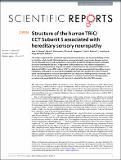Structure of the human TRiC/CCT Subunit 5 associated with hereditary sensory neuropathy
Author(s)
Pereira, Jose H.; McAndrew, Ryan P.; Ralston, Corie Y.; King, Jonathan A.; Adams, Paul D.; Sergeeva, Oksana Andrei; ... Show more Show less
Downloads41598-017-03825-3.pdf (2.312Mb)
PUBLISHER_POLICY
Publisher Policy
Article is made available in accordance with the publisher's policy and may be subject to US copyright law. Please refer to the publisher's site for terms of use.
Terms of use
Metadata
Show full item recordAbstract
The human chaperonin TRiC consists of eight non-identical subunits, and its protein-folding activity is critical for cellular health. Misfolded proteins are associated with many human diseases, such as amyloid diseases, cancer, and neuropathies, making TRiC a potential therapeutic target. A detailed structural understanding of its ATP-dependent folding mechanism and substrate recognition is therefore of great importance. Of particular health-related interest is the mutation Histidine 147 to Arginine (H147R) in human TRiC subunit 5 (CCT5), which has been associated with hereditary sensory neuropathy. In this paper, we describe the crystal structures of CCT5 and the CCT5-H147R mutant, which provide important structural information for this vital protein-folding machine in humans. This first X-ray crystallographic study of a single human CCT subunit in the context of a hexadecameric complex can be expanded in the future to the other 7 subunits that form the TRiC complex.
Date issued
2017-06Department
Massachusetts Institute of Technology. Department of BiologyJournal
Scientific Reports
Publisher
Nature Publishing Group
Citation
Pereira, Jose H. et al. “Structure of the Human TRiC/CCT Subunit 5 Associated with Hereditary Sensory Neuropathy.” Scientific Reports 7, 1 (June 2017): 3673 © 2017 The Author(s)
Version: Final published version
ISSN
2045-2322